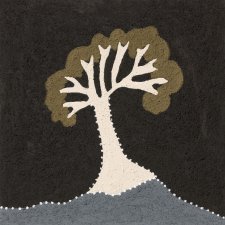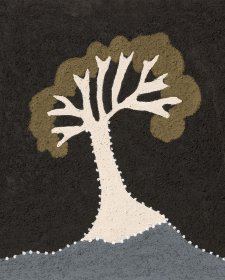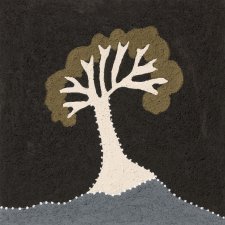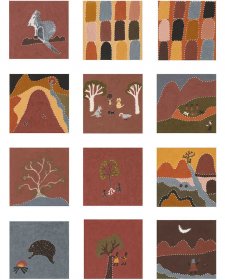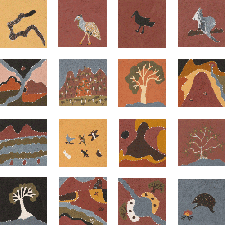Ngarranggarni (Dreaming) is an expansive and complex concept that defies simple definition or translation. Ngarranggarni continues to encode, nourish and maintain Gija law and social organisation, providing a framework for trade and exchange, kinship relations and family ties, custodianship of Country and the practice of art, song, dance and spirituality.

“These three woman (three circles), they been rolling that spinifex by the water and that barramundi been jump through (the hills). This country is for my other great-great grandmother, that’s for my mother for grandmother, my mother’s father’s mother.”
The country Shirley illustrates here is Dayiwool or Argyle. That was Shirley’s maternal great-grandmother’s country. Shirley paints the Ngarranggarni associated with her great-grandmother’s country. In this dreaming, there were three women rolling spinifex, which is depicted by the green ochre. The barramundi jumped through the gap between the hills. A long time ago, there was no gap in those hills, and the story of the barramundi explains how the gap formed between those hills. Also, a long time ago, when Gija people used to go fishing, barramundi would get stuck while trying to swim through the spinifex, which was used as a net. There is a song for this dreaming, which Shirley has been taught to sing, and often performs nowadays at Argyle, during Welcome to Country ceremonies.
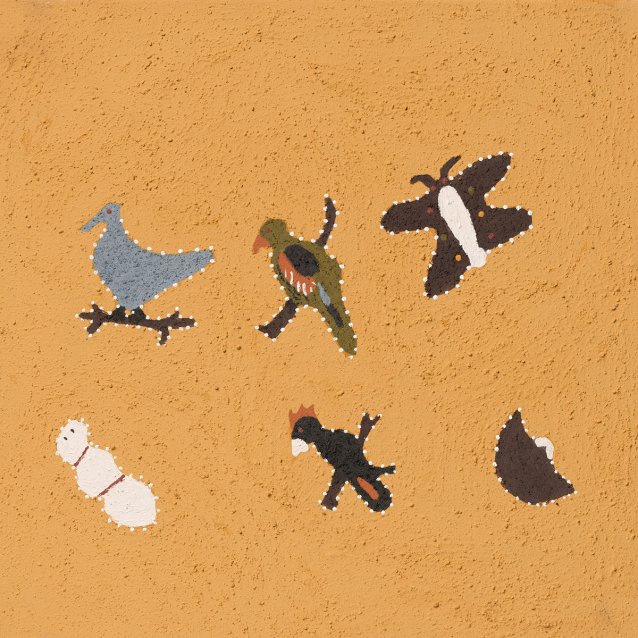
“My grandmother used to tell my uncle that he couldn’t call these ones names. That’s the witchedy grub; what them gardiya call them the stormbird; the crimson and green parrot; the butterfly; the black cockatoo; that one sounds like a swearword in Gija, but gardiya won’t understand that, that one’s like a mussel. That’s all the things that my grandmother told them young boys they couldn’t say. Now I am teaching my young boys that they can’t say these things either.”
In Gija culture, men and women have special relationships with plants and animals that are gender-specific. They have ‘gukbull’ which is sort of like ‘lambarra’ or an avoidance relationship. But when these men are older, or when they have their own children, then they can say the names of these things again.
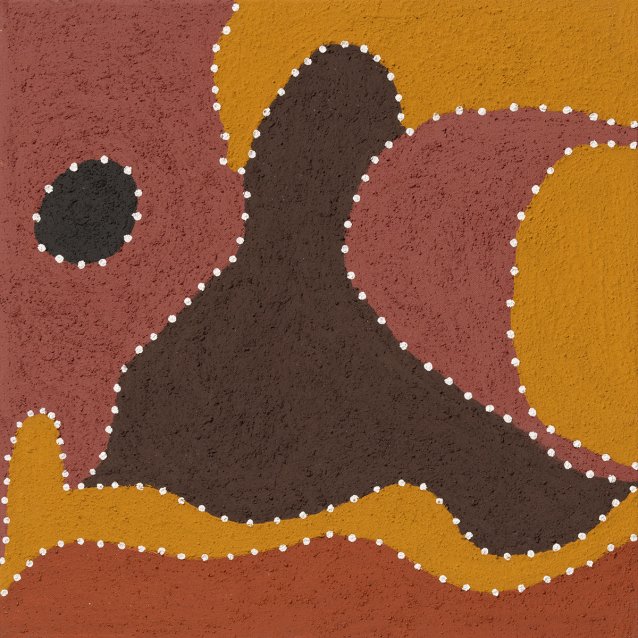
“This bush woman bin come from my country (from Rattigan’s Yard). She went east to live, to get married that way (in Oongbul, aka Corkwood Yard).”
In Shirley’s painting, there is a big cave (big dark space in the centre). The cave is in Corkwood Yard, and can only be seen by helicopter, because it has too many big hills to access by land. Yarralalil was a bush woman who lived in that cave. When Shirley’s family (her father and uncle) used to go mustering in Corkwood Yard, they used to see the bush woman come out of the cave (she is portrayed as the black circle, dotted with white). Shirley chose to depict the woman this way because she wanted to indicate her position, or where she was sighted. Yarralalil lived as a bush woman alone in that cave, without any influence from the external world.
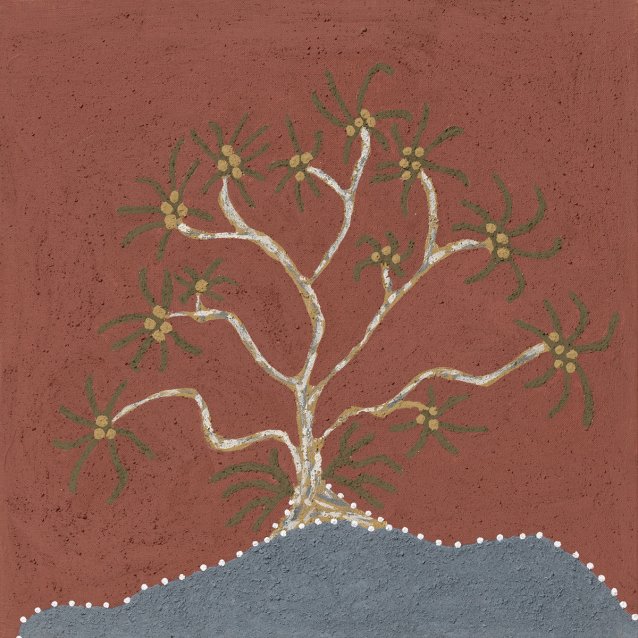
“When the people used to go out bush, something always happened to them with that Rainbow Serpent; maybe something dangerous. This Winbul is a pandanus. It is when people used to go out and they drowned, then they would become this tree. The tree here is near la water in my mum’s country right over way past Violet Valley right over the other side of Warmun, far away. The tree is important one because the biggest mob of people used to go for holiday and that thing (drownings) happened, and they turned into this tree.”

“This is that bush yam. This is my mother (right) and he bin teach me (left) for diggin’ when I bin a little girl. This tucker now, this potato or root. When this tree gets yellow, that’s the time we go and dig him.”
This is bush tucker knowledge Shirley’s mother passed down to her. When she was a young girl, around ten years old, her mother would teach her how to dig up the root of the bush yam tree. She learned that when the tree flowered yellow, it was the correct time to dig up the roots. Generally, this happens in ‘wangan’ or cold weather/winter. However, Shirley has noted that climate change is affecting the seasonal flowering, and sometimes this tree bears yellow flowers when it is not supposed to.

“My great-great grandmother, she told that two birds, they not strangers. They like a family to her. And she sang that song ‘goorra-goorral bomangerri jeggejegge bomangerri jillijilyerji oobujoobuj ngenaninggi’.”
This is the special hill (brown one to the top right), when people pass away, that hill makes noise (rumbles). The two circles in the centre – gardiya used to call them tanks but they are the dreamtime story for the turtle who bin carrying that crocodile in paperbark, looking for water til he bin go down south and find water in la Ord River, in another country. The two circles are where the turtle was looking for water in my country, Violet Valley, and left those marks with his digging stick, looking for water.
This story takes place in Violet Valley, when Shirley’s father’s grandmother was still alive.
The story about Shirley’s great-great grandmother took place on Goorra-Goorral country, or stormbird and Willy wagtail country, because those birds have always lived there. Shirley’s great-great grandmother, Mamigool aka curlew, would dig up the roots of a creeper bush potato plant that grows in that country. She sang a special song to the birds, telling them they were like her family. That song has been passed down to Shirley from her great-great grandmother to her father, who sang it to young Shirley. Shirley never met Mamigool, but she knows about her, and knows her special song. Nangari is the skin name for Wangganal (the crow) and it is also Shirley’s skin. In Gija kinship systems, Nangari helps define who Shirley is within her wider family and community, and how others may relate to her.

“This one, when we see a rainbow, our elders told us that we would see a little blue-tongue lizard at the end of the rainbow. It’s a Dreamtime story for rainbows but it’s not the same thing as the Rainbow Serpent. So, this one is for when it is raining, and you see a rainbow. We call that blue-tongue lizard Lummugull.”
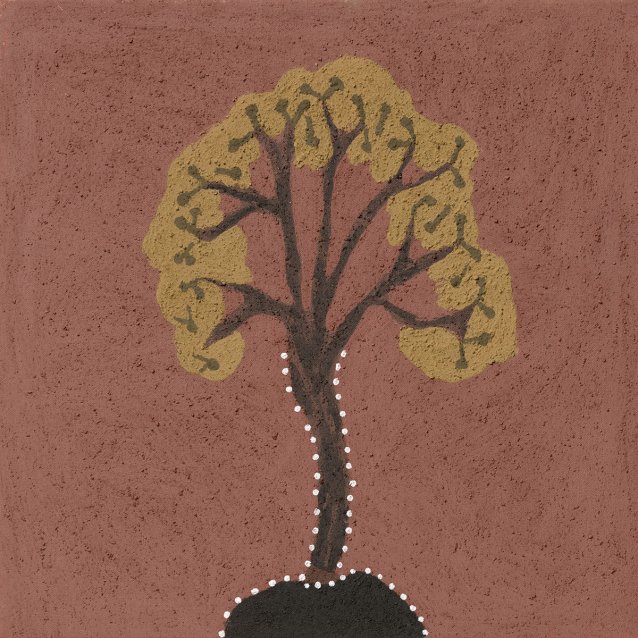
“This is a bush orange tree, but the fruit isn’t orange, it’s green. This is a girl tree, and all the teenage boys are not allowed to call that name because it’s our law. They can go near the tree, and eat the fruit, but they are not allowed to call its name. We can use it for smoking too, to get rid of bad spirits (the leaf). When people have bad dreams, we can use it.”
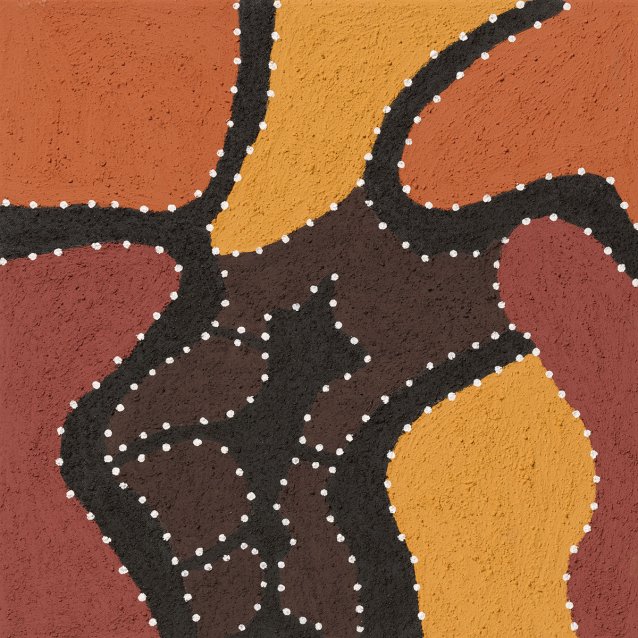
“The Marliwal was pouring all these rocks to form the caves so that all the other wallabies could live in there with their families.”
These black rock formations can be seen in present day Warmun and around Norton Bore, Shirley’s paternal ancestral lands. They’re called ‘Thurru thurru wanannyanda’, meaning ‘pouring around’.
“That’s the Ngarranggarni for this one now – the Marliwal, that girl wallaby… You can see some of them black-black rocks around here.”
The hills in the painting in orange, yellow and red ochre surround the black rocks and caves. The Marliwal Ngarranggarni takes place next to the eagle and crow Dreaming, which are beside a giant hill near the present day roadhouse in Warmun.
All images © Shirley Purdie/Copyright Agency, 2020
